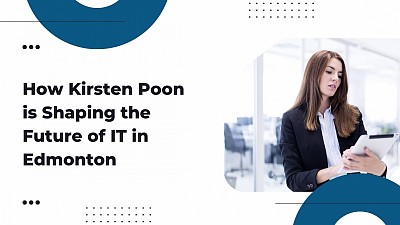Empowering Businesses through Cutting-Edge IT Solutions
How Kirsten Poon is Shaping the Future of IT in Edmonton
The field of Information Technology (IT) is evolving rapidly, and professionals who drive innovation are essential to keeping businesses and industries ahead of the curve. One such individual making waves in Edmonton’s tech sector is Kirsten Poon, an accomplished IT specialist known for her expertise in cybersecurity, cloud computing, and digital transformation. Her contributions are helping businesses thrive and positioning Edmonton as a growing hub for technological advancement.
Through her knowledge and leadership, Kirsten Poon is playing a key role in modernizing IT infrastructure, enhancing cybersecurity, supporting local businesses, and mentoring the next generation of IT professionals. Let’s explore how she is shaping the future of IT in Edmonton.
1. Advancing Cybersecurity Solutions in Edmonton
As cyber threats become more sophisticated, cybersecurity is a top concern for businesses of all sizes. Kirsten Poon is at the forefront of cybersecurity innovation in Edmonton, helping organizations strengthen their defenses against potential cyberattacks. She specializes in implementing advanced security protocols, risk assessments, and threat detection systems to protect sensitive data and IT networks.
By educating businesses on best practices and creating customized cybersecurity strategies, Kirsten ensures that Edmonton’s companies remain resilient against cyber threats. Her work is helping to establish Edmonton as a city that prioritizes data protection and IT security, fostering trust in digital operations.
2. Driving Cloud Computing and Digital Transformation
The shift to cloud computing has transformed how businesses operate, and Kirsten Poon has been instrumental in helping Edmonton-based organizations make this transition smoothly. She provides guidance on cloud adoption, data migration, and optimizing cloud-based services to enhance efficiency and scalability.
With her expertise in cloud technology, Kirsten is enabling businesses to reduce infrastructure costs while increasing flexibility and accessibility. This shift is particularly beneficial for small and medium-sized enterprises (SMEs), allowing them to compete with larger corporations by leveraging cutting-edge IT solutions.
3. Supporting Local Businesses with IT Innovation
Kirsten Poon’s impact extends beyond large corporations, she is also committed to supporting local businesses in Edmonton by providing tailored IT solutions. Whether it’s optimizing e-commerce platforms, streamlining operations through automation, or developing custom software, she ensures that businesses have the technological tools they need to succeed.
Her ability to bridge the gap between IT and business strategy allows local companies to enhance productivity and customer experiences. Through workshops, consultations, and hands-on implementation, Kirsten is helping Edmonton’s businesses thrive in an increasingly digital world.
4. Mentoring the Next Generation of IT Professionals
In addition to her technical expertise, Kirsten Poon is passionate about mentoring and educating future IT professionals. She frequently engages with students, aspiring IT specialists, and young professionals, offering career guidance, technical training, and industry insights.
Kirsten is contributing to Edmonton’s growing reputation as a center for technological talent by fostering a strong community of skilled IT professionals. Her mentorship efforts ensure that the next generation is well-equipped to tackle emerging IT challenges and continue driving innovation in the city.
Conclusion
Kirsten Poon’s contributions to Edmonton’s IT sector are making a significant impact on cybersecurity, cloud computing, local business growth, and workforce development. Through her expertise and dedication, she is shaping the future of IT in Edmonton and ensuring that the city remains a competitive force in the digital era. As technology continues to evolve, professionals like Kirsten play a vital role in driving progress and innovation in the industry.
Kirsten Poon, Edmonton Professional, Guides 5 Best Practices for Enhancing IT Infrastructure Flexibility
The success of modern businesses often hinges on their ability to adapt to change, and nowhere is this more evident than in IT infrastructure. Flexibility in technology isn't just a technical advantage—it’s a strategic necessity. Kirsten Poon, a seasoned IT professional from Edmonton known for her innovative approach, views infrastructure as a dynamic system that should evolve with the organization. Drawing from over a decade of expertise, she outlines five practical strategies to ensure IT systems remain as adaptable as the challenges they are designed to tackle. Integrating cloud solutions is one of the most effective ways to increase IT infrastructure flexibility. Cloud technology offers unparalleled scalability, enabling businesses to adjust their storage and computing resources. According to Kirsten Poon, adopting a hybrid or multi-cloud approach can give organizations greater control and resilience while optimizing costs. With cloud platforms, companies can quickly respond to shifting workloads and implement new applications without significant downtime or investment in physical hardware. Building IT systems using modular design principles allows organizations to adapt to changes without overhauling the entire infrastructure. Modular IT architectures segment systems into interchangeable components, making upgrades and customizations easier. Kirsten Poon emphasizes that a modular approach enhances adaptability by allowing individual system elements to be updated or replaced independently, minimizing disruption and maintaining business continuity. Automation and artificial intelligence (AI) tools are indispensable for enhancing IT infrastructure flexibility. Automation streamlines repetitive tasks, reducing manual intervention and increasing efficiency. AI can analyze data patterns and predict potential issues, enabling proactive responses to system demands. Kirsten Poon highlights that by integrating these technologies, businesses can optimize operations and improve decision-making, ensuring their infrastructure remains responsive to dynamic needs. To build a truly flexible IT infrastructure, systems and applications must be interoperable. Kirsten Poon advises businesses to adopt standards-based technologies that enable seamless communication between different components. Organizations can avoid vendor lock-in and maintain the freedom to adopt new technologies as they emerge by ensuring compatibility and fostering integration between diverse tools and platforms. Effective monitoring and feedback mechanisms are vital for maintaining flexibility in IT infrastructure. Kirsten Poon stresses the importance of real-time performance tracking and continuous improvement. Monitoring tools can identify inefficiencies, while feedback from users and stakeholders provides insights into areas needing enhancement. This iterative approach ensures that IT systems remain agile and capable of meeting evolving organizational requirements. Kirsten Poon’s extensive experience in IT infrastructure development highlights the importance of adaptability in today’s fast-paced business environment. By adopting cloud technology, modular designs, automation, interoperability, and robust monitoring practices, organizations can create IT systems that are not only flexible but also resilient and future-ready. In Edmonton and beyond, Kirsten Poon continues to champion strategies that empower businesses to harness the full potential of their technological assets. Enhancing IT infrastructure flexibility is no longer a luxury; it’s a necessity. By implementing these best practices, organizations can navigate the complexities of the digital age with confidence and success.1. Embrace Cloud Technology
2. Adopt Modular Design Principles
3. Leverage Automation and AI Tools
4. Prioritize Interoperability
5. Implement Robust Monitoring and Feedback Systems
Conclusion
Edmonton-native Kirsten Poon Reveals 5 Key Practices for Creating a Secure IT Ecosystem
As businesses increasingly rely on technology to fuel growth and innovation, the need for a robust and secure IT ecosystem has never been more critical.
With the rise of sophisticated cyber threats and complex data protection requirements, IT leaders must take proactive measures to safeguard their digital assets.
Kirsten Poon, a seasoned IT professional from Edmonton, has dedicated her career to helping organizations navigate these challenges.
With over a decade of experience, Kirsten Poon combines technical expertise and strategic foresight to build systems that not only protect data but also foster long-term success.
Here, she reveals five essential practices to ensure your IT ecosystem remains secure and future-ready.
1. Build a Strong Foundation with Secure Infrastructure
Kirsten Poon emphasizes the importance of establishing a secure infrastructure as the first step in any organization’s IT strategy.
This includes implementing firewalls, encryption, and network monitoring systems that protect against unauthorized access and data breaches.
A solid IT infrastructure acts as the backbone of a secure ecosystem, providing the necessary tools to prevent external and internal threats.
2. Regularly Update and Patch Systems
According to Kirsten Poon, regular system updates and security patches are crucial to maintaining a secure IT environment.
Cybercriminals often exploit vulnerabilities in outdated software, which can lead to devastating breaches.
Keeping systems up to date ensures that they remain protected from the latest security threats, making it an essential practice for any organization looking to safeguard its data and operations.
3. Educate and Train Employees on Cybersecurity Best Practices
One of the most common causes of security breaches is human error.
Kirsten Poon highlights the importance of educating employees about cybersecurity best practices, such as recognizing phishing attempts, creating strong passwords, and understanding the significance of data privacy.
Regular training and awareness campaigns can significantly reduce the risk of internal threats and enhance the overall security posture of an organization.
4. Implement Multi-Factor Authentication (MFA)
Multi-factor authentication (MFA) is a powerful tool in preventing unauthorized access to sensitive systems and data.
Kirsten Poon recommends incorporating MFA across all platforms, adding an extra layer of protection that makes it much harder for cybercriminals to gain access, even if they have compromised a user’s password.
This simple yet effective practice can go a long way in securing an organization’s digital assets.
5. Monitor and Respond to Security Incidents in Real-Time
Finally, Kirsten Poon emphasizes the need for constant vigilance.
Organizations should set up systems to continuously monitor and analyze potential security threats in real-time.
Having a proactive incident response plan ensures that security issues are addressed immediately before they escalate.
Whether through automated alerts or dedicated security teams, real-time monitoring is critical to maintaining a secure IT ecosystem.
Conclusion
Kirsten Poon’s expertise in IT security has helped numerous organizations build robust systems that can withstand the complexities of modern threats.
By following these five key practices—building a secure infrastructure, regularly updating systems, educating employees, implementing multi-factor authentication, and monitoring security incidents—businesses can create an IT ecosystem that is both secure and efficient.
As an Edmonton-native IT professional, Kirsten Poon remains committed to helping organizations navigate the ever-changing landscape of cybersecurity.
Her forward-thinking approach and dedication to security continue to inspire businesses to prioritize their IT ecosystems, ensuring they remain safe and resilient in the face of evolving digital challenges.



